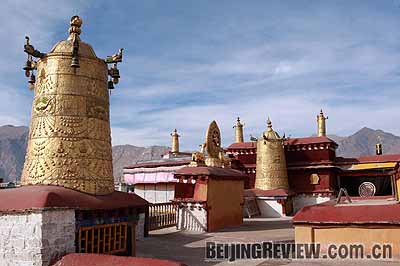|
 |
|
JOKHANG MONASTERY: Tibet's oldest Buddhist temple was included in the list of 22 Tibetan cultural relics to be repaired from 2006-10 (JIANG XIAOYING) | In this issue of Beijing Review, our reporters cover a giant project to repair the Sakya Monastery in Tibet Autonomous Region, which is expected to complete later this year. The 86-million-yuan ($12.3 million) project is the first in 60 years for this central monastery of the Sakya sect of Tibetan Buddhism.
The overhaul of the Sakya Monastery is one of the many examples of how the Chinese Government is protecting Tibetan Buddhism and promoting its development.
Respect and protection of the freedom of religious belief is one of China's fundamental state policies and this can be evidenced by the way it has been put into practice in Tibet in the past decades.
Since the 1980s, the Central Government has allocated more than 700 million yuan ($100 million) for the preservation of cultural and religious sites in Tibet. The overhaul of the Potala Palace in Lhasa in 1989-94 alone cost 55 million yuan ($8 million) and used a huge amount of gold and silver. Since June 2002, more than 330 million yuan ($47 million) has been appropriated for the maintenance of the Potala Palace, the Norbu Lingka Palace and the Sakya Monastery. A lot of religious documents and classics have also been collected, collated and published.
The Chinese Government's efforts to preserve Tibetan Buddhism, as well as other local cultural traditions, have been recognized by Tibetans and unbiased people from around the world.
However, the 14th Dalai Lama and his followers, who seek to split Tibet from China, have accused the Chinese Government of waging a "cultural genocide" in the region and suggested "cultural autonomy" for the Tibetan people.
It is noticeable that the backward feudal serfdom system, culture of theocratic rule and religious despotism that prevailed in Tibet under the rule of the 14th Dalai Lama, contributed to cultural resources being monopolized by a small number of serf owners. This situation remained unchanged until the Democratic Reform in 1959.
The 14th Dalai Lama and his followers' clamor for "cultural autonomy" for the Tibetan people is essentially for the purpose of restoring the theocratic rule over the culture of Tibet and other Tibetan-inhabited regions, and thus realize their aim of the "independence of Greater Tibet." Such a scheme has never won majority support in Tibet, where ordinary people'e life are greatly improving and local culture is thriving. | 